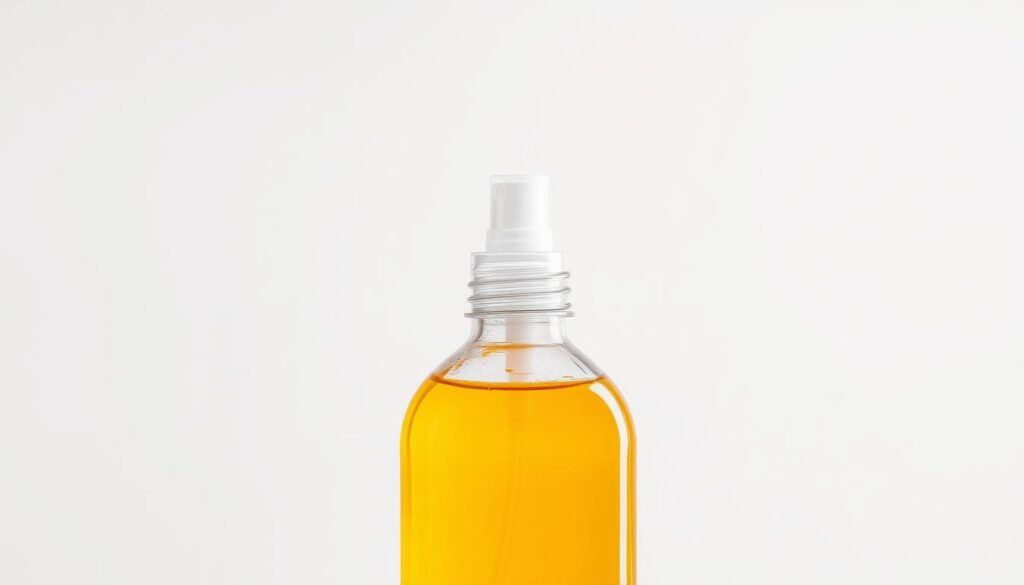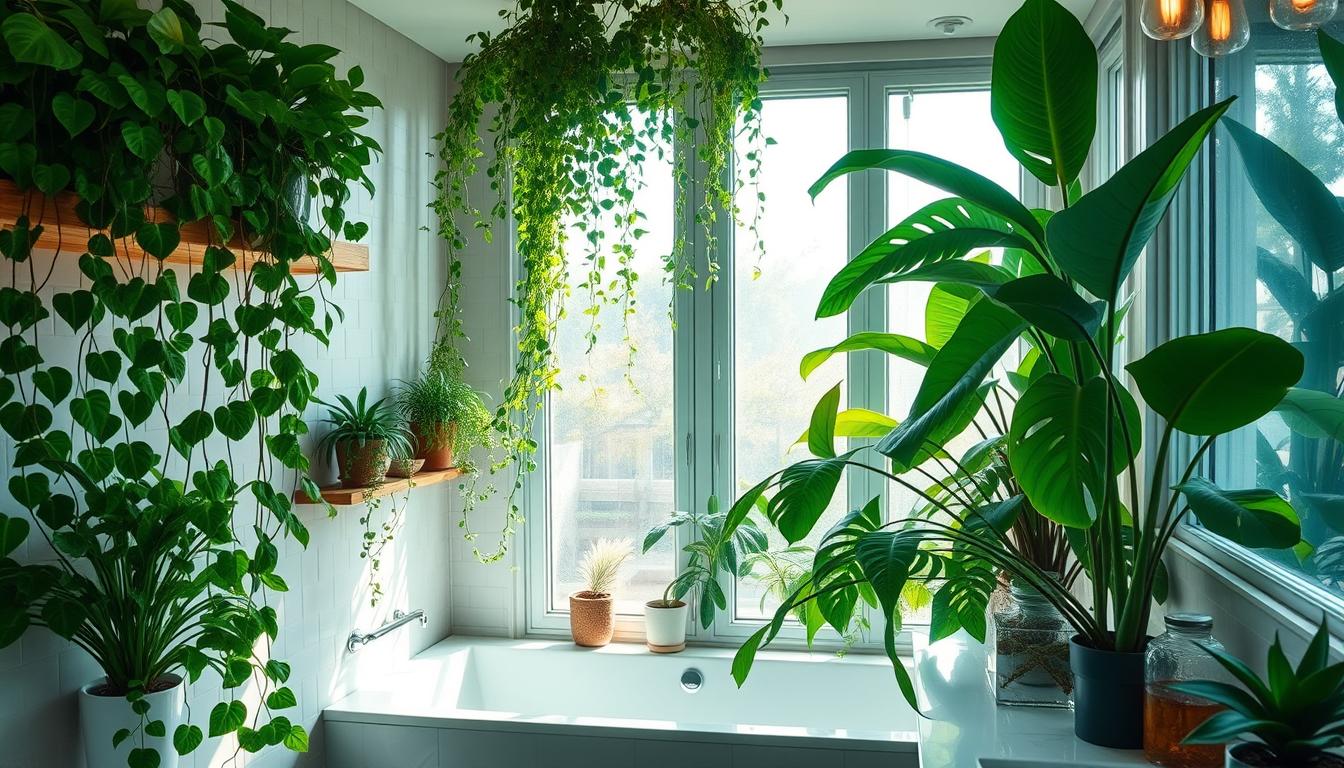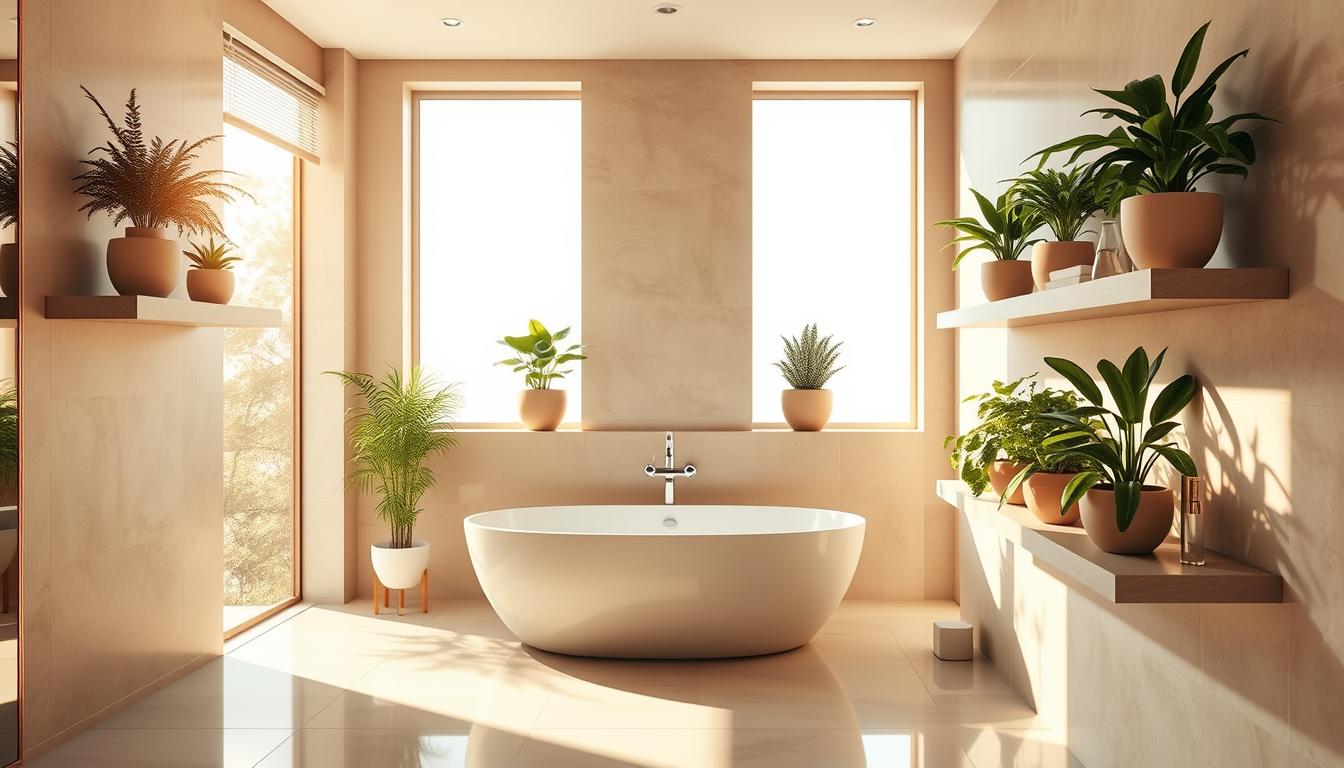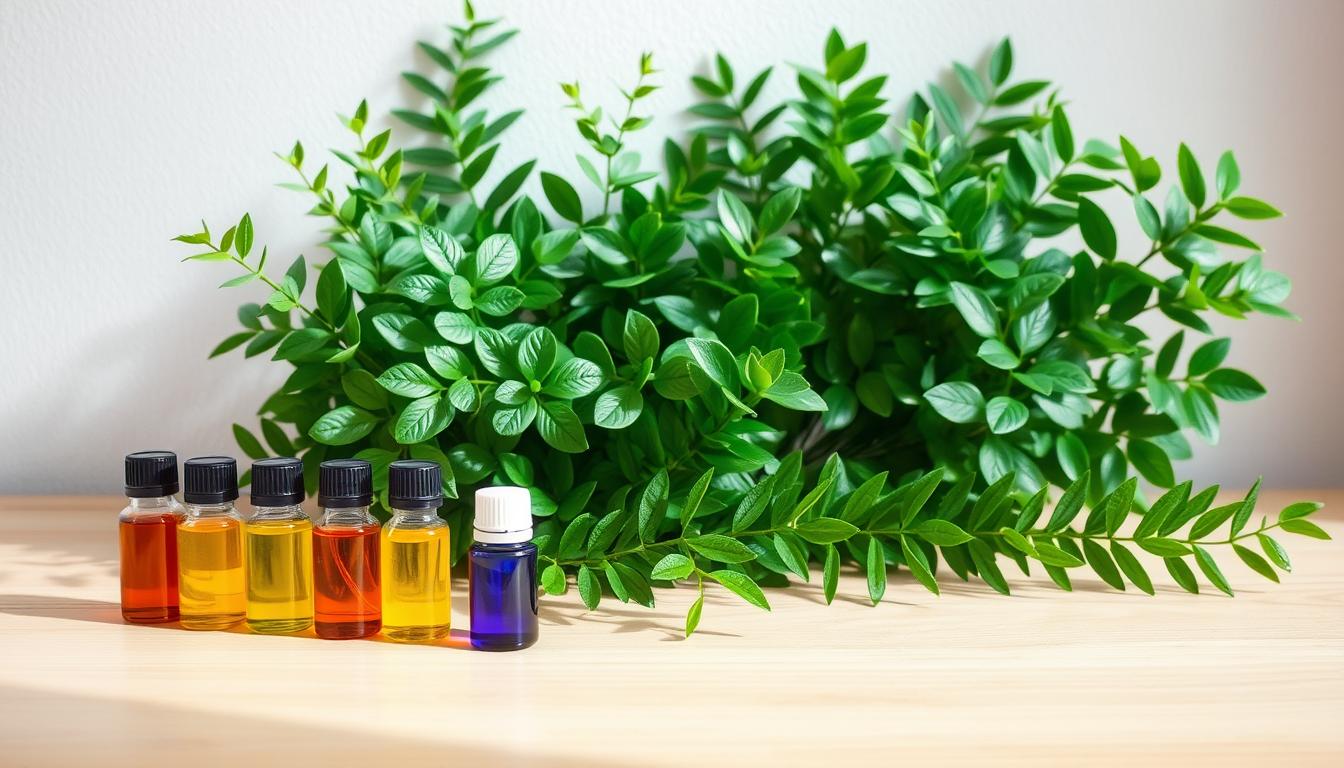Keeping your bathroom decor fresh and vibrant can seem tough. Especially with dusty fake plants around. Bathrooms are moist, and this moisture attracts dust to artificial flowers, made worse by static.
In this article, we’ll look at how to tackle static cling. We’ll focus on dusty fake plants. We’ll share cleaning strategies that make your artificial flowers look good. And keep them beautiful for a long time.
Understanding Static Electricity in Fake Plants
Static electricity is key in keeping artificial flowers clean. Knowing how static works, especially with synthetic materials, helps clean them better. Fake plants catch a lot of dust because of how they’re made and what they’re made of.
What Causes Static Electricity?
Static electricity happens when two surfaces touch and then separate, creating an electric charge. This is important for understanding static in fake plants. Since they are often made of plastics, which are insulators, they easily get charged and attract dust.
How Does Static Affect Cleaning Fake Plants?
Cleaning artificial flowers gets trickier with static. The charged surfaces of the plants pull in dust, holding onto it tightly. This means we need special methods and products to fight static. That way, fake plants can stay looking clean and fresh.
Common Materials of Fake Plants and Their Static Properties
It’s important to know about the materials in artificial flowers to keep them looking good. Fake plants often use plastics like PVC and PET. These plastics have special static qualities that impact how fake plants behave.
Types of Plastics Used in Artificial Flowers
Many different plastics are used to make fake plants look real and last longer. Important materials include:
- PVC (Polyvinyl Chloride): It’s bendy and tough but attracts dust due to its surface.
- PET (Polyethylene Terephthalate): This material is clear and strong and resists water well but can get static-y.
- Polyethylene: Used for leaves and stems, it’s light but collects dust easily.
Why Some Plastics Are More Prone to Static Build-Up
The static tendency of plastics depends on their chemical makeup. Materials like PVC and PET get staticky because they don’t conduct electricity well. Also, the environment matters:
- Dry air can make static worse, attracting more dust to surfaces.
- Touching them a lot can also increase static, especially in dry places.
To keep artificial flowers fresh, choosing the right way to clean them is key. This helps control their static levels.
Static Cling Solutions for Dusty Fake Plants in Moist Bathrooms
Bathrooms have lots of humidity, making it tricky to clean fake plants. Humidity and dust stick together a lot there. By understanding how moisture affects static, you can keep fake plants looking good. Choosing the right tools helps a lot in keeping them clean.
Impact of Humidity on Dust Attraction
Humidity makes a big difference in how dust sticks to fake plants. When it’s humid, static on surfaces can change. This can make more dust stick. Keeping an eye on humidity in your bathroom helps with less dust and easier cleaning.
Choosing Anti-Static Products for Bathroom Use
It’s important to pick the right anti-static products for cleaning fake plants in bathrooms. Choose products made for humid areas. They help fight static and keep dust off. Look for sprays or cloths that keep your fake plants looking nice without harming them.
The Role of Moisture in Dust Retention
Bathrooms are key areas where moisture affects dust sticking. High humidity makes dust stick more to surfaces. Limited airflow in small spaces makes this worse by not letting air move, causing more humidity.
Why Bathrooms Accumulate More Dust
Maintaining cleanliness in bathrooms is hard due to several factors. These include:
- Increased moisture levels attract dust particles.
- Frequently used personal care products leave residue on surfaces.
- Limited ventilation confines dust, making it harder to remove.
Managing Humidity to Reduce Dust
To fight dust in bathrooms, controlling humidity is key. Here are ways to help:
- Use a dehumidifier to keep humidity low.
- Ensure proper ventilation by using exhaust fans.
- Open windows to let in fresh air.
Effective Dusting Techniques for Fake Plants
Keeping artificial flowers looking their best needs good dusting methods. Picking the right tools helps prevent harm and cleans well. There are various dusters designed for fake flowers. Here are some tips and recommendations to keep your fake plants looking new.
Using Different Types of Dusters
For artificial flowers, the type of duster is key. Microfiber dusters are great because they pick up dust well without scratches. Lambswool dusters are also soft and catch dirt effectively. You can also use:
- Compressed air or blow dryers for tiny spaces.
- Soft-bristle brushes for detailed areas.
- Gentle vacuum attachments for soft cleaning.
Tips for Avoiding Damage to Artificial Flowers
Taking care of artificial flowers means avoiding harm when cleaning. Consider these tips:
- Always dust lightly to keep petals and leaves in place.
- Don’t use strong chemicals or rough materials.
- Regular, gentle dusting means less need for harsh cleaning later.
Using these dusting tips will help your artificial flowers stay lovely and bright. With the right tools and methods, you can keep your decorations in great shape and control dust.
DIY Static Cling Solutions
Combatting dust and static cling on artificial flowers makes them last longer and look better. Many people like DIY methods because they’re simple and good for the planet. Using a citrus spray or salt to remove dust are great techniques.
Creating a Citrus Cleaning Spray
Making a citrus spray is a fresh, natural way to clean artificial flowers. Mix lemon juice and water for a spray that fights static cling. Here’s how to make it:
- Mix one cup of water with two tablespoons of lemon juice in a spray bottle.
- Shake well before each use.
- Lightly mist the artificial flowers from a distance.
- Wipe down with a soft cloth, ensuring not to saturate the flowers.
Using this citrus spray often will keep artificial flowers bright and reduce dust.
Salt Treatments for Dust Removal
Coarse salt can also remove dust effectively. It’s especially good for tough dust. Here’s how to do it:
- Put the artificial flowers in a large plastic bag.
- Add a few tablespoons of coarse salt to the bag.
- Seal the bag and shake gently.
- Remove the flowers and lightly brush off any remaining salt.
This salt method is simple, green, and works well. Using salt not only removes dust but also helps keep your home clean.

Commercial Products for Dusting Fake Plants
If you’re looking for an easy way to clean fake plants, check out commercial products. There are great dusters and anti-static sprays made just for artificial decorations. They help keep your fake plants looking good for longer.
Best Dusters Specifically for Fake Plants
For cleaning fake plants, some dusters work better than others. The Swiffer Heavy Duty Dusting Kit is perfect because it catches dust without hurting the plants. It uses microfiber technology to grab dust gently. Also, the OXO Good Grips Microfiber Extendable Duster and the Reusable Feather Duster are good. They’re designed to clean well and are easy to use.
Top Anti-Static Sprays and Wipes
To keep fake plants free of static, using a top anti-static spray is important. Static Guard and Endust are great choices that fight static and remove dust. For a quick cleanup, anti-static wipes by 3M or Pledge work well. They keep your fake plants looking fresh and stop dust from sticking.
Maintaining Your Fake Plants to Combat Dust
Starting a cleaning routine is crucial for keeping artificial flowers looking new. It helps to keep dust down and avoids static, making care easier. Here are some tips on making a cleaning plan for your fake plants and how to take care of them for a long time.
Regular Cleaning Routines
Cleaning your fake flowers often is important. Setting up a cleaning schedule makes them look better and last longer. Try these steps:
- Dust your fake plants weekly using a soft microfiber cloth or a gentle duster.
- If needed, spray a mild cleaning solution designed for synthetic materials to remove any stubborn dirt.
- Use anti-static sprays occasionally to help prevent dust from settling on the surfaces.
Long-Term Care Tips for Artificial Flowers
Looking after your fake plants well means more than just dusting. Use these tips for keeping them at their best:
- Store plants away from direct sunlight to prevent fading and material degradation.
- Place them in a low-humidity environment to further reduce dust attraction.
- Consider using protective agents that create barriers against dust and dirt buildup.
Conclusion
Static cling solutions are key for keeping fake plants dust-free, especially in moist bathroom areas. They help us understand static electricity better. This lets us tackle the issue head-on. Plus, using top cleaning tips for these plants cuts down dust buildup.
It’s important to know which materials are used in fake flowers and how they attract dust. Using the proper cleaning practices and products, like anti-static sprays and dusters, keeps your fake plants looking good. These steps help your artificial greenery stay fresh and appealing.
Adding these methods to your cleaning habits does more than make things look nice; it makes your home feel nicer. Using good static cling solutions helps keep your plants looking great for a long time.



